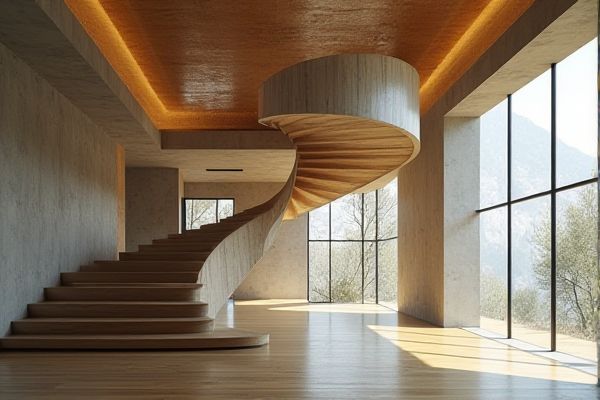
A floating spiral offers flexibility and dynamic movement, ideal for applications needing adaptability, while an anchored spiral provides stability and fixed positioning, ensuring consistent structure under stress. Explore the rest of the article to discover which spiral type best suits your specific needs.
Table of Comparison
| Feature | Floating Spiral | Anchored Spiral |
|---|---|---|
| Definition | A spiral structure that is suspended or not fixed to a base. | A spiral structure firmly fixed or attached to a stable surface. |
| Stability | Less stable, can move or sway. | Highly stable and immobile. |
| Installation | Requires suspension mechanisms. | Requires anchoring hardware or foundation. |
| Applications | Decorative elements, flexible designs. | Structural support, load-bearing applications. |
| Durability | Potentially less durable due to movement. | More durable with secure fixation. |
| Cost | Generally lower installation cost. | Higher installation cost due to anchoring. |
Introduction to Spiral Designs
Floating spirals feature open, unattached coils that create a sense of motion and lightness in design, making them ideal for dynamic visual elements in art and architecture. Anchored spirals are firmly connected to a central point or structure, providing stability and a grounded aesthetic commonly used in mechanical and structural applications. These distinct structural characteristics influence the choice of spiral designs in various creative and engineering contexts.
Understanding Floating Spirals
Floating spirals operate independently from any fixed structures, allowing them to move freely within fluids or air currents, which is essential for applications requiring dynamic positioning and adaptability. Anchored spirals, in contrast, are fixed to a stationary point, providing stability and consistent orientation, crucial for precision in devices such as gyroscopes or microelectromechanical systems (MEMS). Understanding floating spirals involves examining their ability to respond to environmental changes without the constraints of anchoring, which impacts their behavior in sensors, robotics, and fluid dynamics research.
Exploring Anchored Spirals
Anchored spirals provide stable, fixed points in spiral designs, enhancing structural integrity and precision, unlike floating spirals which rely on freeform, dynamic movement. The anchored spiral's attachment to a central axis allows for controlled expansion and predictable geometric patterns essential in engineering and architectural applications. This stability is crucial for applications requiring exact measurements and consistent spacing, such as in spiral staircases or mechanical springs.
Key Differences Between Floating and Anchored Spirals
Floating spirals are designed to move freely within the uterus, reducing discomfort and making them easier to insert, while anchored spirals have arms or hooks that fix the device firmly in place, enhancing stability and reducing the risk of expulsion. You may find floating spirals more suitable for those seeking a less invasive option, whereas anchored spirals provide longer-lasting protection through their secure positioning. Key differences also include varying rates of cramping and expulsion, with anchored spirals typically causing more initial discomfort but ensuring consistent contraception.
Structural Considerations
Floating spirals rely on buoyant forces and flexible anchors to maintain shape, requiring materials capable of withstanding dynamic water pressures and currents. Anchored spirals depend on fixed points firmly secured to the seabed or other stable structures, demanding robust foundations and corrosion-resistant materials to ensure long-term stability. Structural considerations for both include tension distribution, load balancing, and resistance to environmental stressors such as waves, tides, and marine growth.
Aesthetic Appeal and Visual Impact
Floating spirals create a dynamic, ethereal visual effect by appearing to hover freely within a space, enhancing modern and minimalist aesthetics with their fluid, open design. Anchored spirals offer a grounded, structured appearance, providing a strong visual anchor that conveys stability and architectural precision. The choice between floating and anchored spirals significantly influences spatial perception, with floating designs emphasizing lightness and movement, while anchored spirals emphasize solidity and form.
Application in Architecture and Art
Floating spirals create dynamic, ethereal forms ideal for modern architectural installations and contemporary sculptures, enhancing spatial experience through visual lightness and fluidity. Anchored spirals, rooted firmly in a base, offer structural stability and are frequently used in staircases, railings, and permanent art pieces to convey strength and continuity. Both types leverage the spiral's natural geometry to evoke movement and growth, but floating spirals emphasize openness while anchored spirals prioritize grounded functionality.
Engineering Challenges and Solutions
Floating spirals face engineering challenges such as maintaining structural stability against water currents and wave forces, requiring advanced materials and flexible anchor systems. Anchored spirals must address seabed anchoring techniques to prevent displacement or damage from environmental stressors, often relying on robust, corrosion-resistant anchoring solutions. Your choice depends on balancing mobility needs and environmental constraints, with engineering adaptations tailored to optimize durability and functionality in marine conditions.
Cost and Material Implications
Floating spirals typically incur higher costs due to the need for specialized materials and precision engineering to maintain stability without fixed support points. Anchored spirals use conventional materials like steel or aluminum, reducing overall expenses by leveraging existing support structures. Material choices for floating spirals often include lightweight composites to minimize weight, whereas anchored spirals can afford heavier, more durable materials due to their fixed nature.
Choosing the Right Spiral for Your Project
Floating spirals offer flexibility and ease of installation, ideal for projects requiring adjustable coil positioning or minimal structural impact. Anchored spirals provide superior stability and durability, making them suitable for long-term applications where secure attachment to a base is essential. Consider your project's specific needs for movement, stability, and environmental exposure to choose the most effective spiral type.
 homyna.com
homyna.com